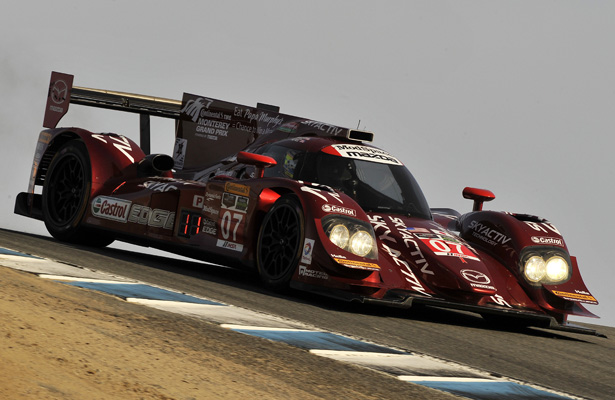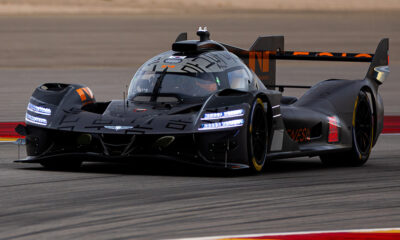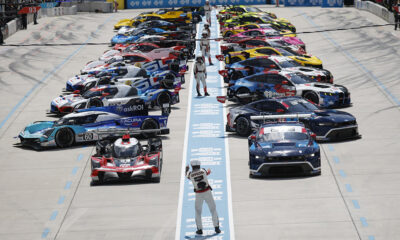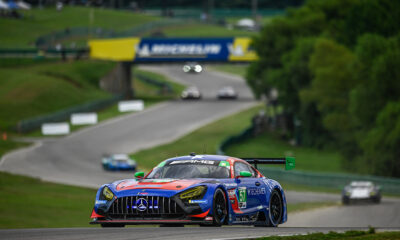
Photo: IMSA
Last weekend’s Continental Tire Monterey Grand Prix proved to be a breakout race for Mazda and its new SKYACTIV-D prototype, which saw Tom Long and SpeedSource team principal Sylvain Tremblay notch a season-best seventh place overall finish.
After a challenging start to its multi-year program, the pair of clean diesel-powered prototypes showed significant gains in both speed and reliability at Mazda Raceway Laguna Seca, in what came at a crucial point in the car’s development.
“In any racing program, you want success but I think Mazda was cognizant of the challenge. We were cognizant of the task and really wanted to showcase what this program could do,” Tremblay told Sportscar365.
“We had some updates planned for Long Beach and had some unfortunate events right at the race where we couldn’t show our speed. We took all of that and made a real effort to have both cars in the same spec for Mazda Raceway.”
It’s been a steep learning curve for Tremblay and everyone at SpeedSource and Mazda, which has taken the same base 2.2-liter four-cylinder turbodiesel engine that was used in the Mazda6 GX cars last year and have installed them into the Multimatic-built, Lola-based P2 cars.
Two of the biggest challenges, Tremblay said, has been engine cooling and drivetrain-related durability, due to the unique characteristics of the production powerplant, which is largely still using stock components.
With many of the early season reliability issues solved, the factory squad was able to roll out a series of new updates last weekend, which cut a nearly 10-second deficit to the leading P cars at Sebring down to less than two seconds at Mazda Raceway.
“We have to be practical and we have to be conservative with the mechanical limits of a lot of the stock components we’re using,” Tremblay said. “We can’t just let it all go and if it goes it goes. That’s not Mazda’s approach. We have a methodical way of rolling out these updates.
“The turning point for us was how much the simulation helped, with how close we unloaded the car to what we raced. A lot of credit goes out to the engineering staff at SpeedSource and Multimatic, our vehicle development partner.
“We did a lot of driver in the loop simulation and we were able to have a great setup. Luckily for us, Mazda Raceway doesn’t have a whole lot of straightaways but it does have some fantastic corners and that’s where we were able to make a lot of the speed.”
The No. 07 entry of Tristan Nunez and Joel Miller showed impressive early race pace, turning laps that equaled those of the leaders, but retired early after getting collected in an accident at the Corkscrew.
Long and Tremblay, however, enjoyed a trouble-free run, in what turned into an 180-degree difference experience while behind the wheel for the team owner.
“It’s like a totally different animal,” Tremblay said. “When you don’t have the power or downforce, you struggle in the corners and you don’t have tire or brake temps you need.
“But once you have the power and the torque, we can get real close real quick. It’s exciting to be running with these guys. It was pretty nice to be held up by the 01 car for a while. We are definitely hungry for more.”
Tremblay said further developments are on their way, with a test scheduled for Palm Beach International Raceway later this month to prepare for a further 10-15 hp increase in power output for the Sahlen’s Six Hours of The Glen in June.
“For us, we always thought it would take a season and a half to be competing up front,” Tremblay said. “Right now, we’re incredibly ahead but we’re also realistic that the wonderful undulations of Mazda Raceway also helped us a whole bunch.
“We should be relatively competitive by Detroit but the next big test for us will be Watkins Glen. It’s a six hour race, so reliability will play a factor and also fuel mileage. We hopefully can be at an advantage.”
With the SKYACTIV-D engine having an upper limit of around 450 hp, Tremblay is hopeful IMSA won’t make further power increases to P2-based cars, as many of the developments they’re rolling out have already been more than a year in the making.
“We hope that P2 cars stay as close to [ACO baseline spec] as possible as we really feel that’s an attainable target,” he said. “If BoP changes and really pushes the power outputs up on the P2 cars, it’s going to be a bigger gap for us. We’re cognizant of that but unfortunately there’s not much left in the bag of what we’re trying to do.”

























